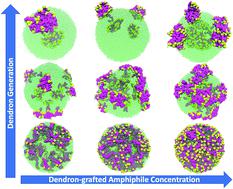当前位置:
X-MOL 学术
›
Nanoscale Adv.
›
论文详情
Our official English website, www.x-mol.net, welcomes your
feedback! (Note: you will need to create a separate account there.)
Dendronized vesicles: formation, self-organization of dendron-grafted amphiphiles and stability
Nanoscale Advances ( IF 4.6 ) Pub Date : 2020-12-21 , DOI: 10.1039/d0na00773k Akash Banerjee 1 , Acacia Tam 1 , Meenakshi Dutt 1
Nanoscale Advances ( IF 4.6 ) Pub Date : 2020-12-21 , DOI: 10.1039/d0na00773k Akash Banerjee 1 , Acacia Tam 1 , Meenakshi Dutt 1
Affiliation

|
Fundamental bacterial functions like quorum sensing can be targeted to replace conventional antibiotic therapies. Nanoparticles or vesicles that bind interfacially to charged biomolecules could be used to block quorum sensing pathways in bacteria. Towards this goal, dendronized vesicles (DVs) encompassing polyamidoamine dendron-grafted amphiphiles (PDAs) and dipalmitoyl-sn-glycero-3-phosphocholine lipids are investigated using the molecular dynamics simulation technique in conjunction with an explicit solvent coarse-grained force field. The key physical factors determining the stability of DVs as a function of the dendron generation and relative concentration are identified. The threshold concentration of each dendron generation that yields stable DVs is determined. Dendrons with lower generations rupture the DVs at high relative concentrations due to the electrostatic repulsions between the terminally protonated amines. Whereas, dendrons with intermediate generations demonstrate a mushroom-to-brush transition. Conformational changes in the dendrons expand the outer DV surface, resulting in instability in the DV bilayer. DVs encompassing dendrons with higher generations incur stresses on the bilayer due to their high charge density and spontaneous curvature. The self-organization of PDAs on the DV surface are examined to understand how the asymmetric stresses are minimized across the bilayer. A set of conditions are determined to be conducive for the formation of a single cluster of PDAs that decorates the DV surface like a mesh. Results from this study can potentially guide the design and synthesis of nanoparticles which target quorum sensing pathways in bacteria towards the prevention and treatment of bacterial infections. Furthermore, these nanoparticles can be used in diverse applications in biomedicine, energy or electronics that require synthetic dendronized cells or the adsorption and transport of charged species.
中文翻译:

树突囊泡:树突接枝两亲物的形成、自组织和稳定性
群体感应等基本细菌功能可以用来替代传统的抗生素疗法。与带电生物分子界面结合的纳米颗粒或囊泡可用于阻断细菌中的群体感应途径。为了实现这一目标,使用分子动力学模拟技术结合显式溶剂粗粒力场研究了包含聚酰胺胺树突接枝两亲物(PDA)和二棕榈酰-sn-甘油-3-磷酸胆碱脂质的树突囊泡(DV)。确定了决定 DV 稳定性的关键物理因素作为树突生成和相对浓度的函数。确定产生稳定 DV 的每一代树突的阈值浓度。由于末端质子化胺之间的静电排斥,具有较低世代的树突在相对高浓度下使 DV 破裂。然而,具有中间代的树突表现出蘑菇到刷子的转变。树突的构象变化扩大了 DV 外表面,导致 DV 双层不稳定。包含更高代树突的 DV 由于其高电荷密度和自发曲率而在双层上产生应力。检查 DV 表面上 PDA 的自组织,以了解如何最小化双层上的不对称应力。确定了一组有利于形成单个 PDA 簇的条件,这些 PDA 簇将 DV 表面装饰成网格状。这项研究的结果可能会指导纳米颗粒的设计和合成,这些纳米颗粒针对细菌中的群体感应途径,以预防和治疗细菌感染。此外,这些纳米颗粒可用于生物医学、能源或电子领域的多种应用,这些应用需要合成树突状细胞或带电物质的吸附和运输。
更新日期:2021-01-05
中文翻译:

树突囊泡:树突接枝两亲物的形成、自组织和稳定性
群体感应等基本细菌功能可以用来替代传统的抗生素疗法。与带电生物分子界面结合的纳米颗粒或囊泡可用于阻断细菌中的群体感应途径。为了实现这一目标,使用分子动力学模拟技术结合显式溶剂粗粒力场研究了包含聚酰胺胺树突接枝两亲物(PDA)和二棕榈酰-sn-甘油-3-磷酸胆碱脂质的树突囊泡(DV)。确定了决定 DV 稳定性的关键物理因素作为树突生成和相对浓度的函数。确定产生稳定 DV 的每一代树突的阈值浓度。由于末端质子化胺之间的静电排斥,具有较低世代的树突在相对高浓度下使 DV 破裂。然而,具有中间代的树突表现出蘑菇到刷子的转变。树突的构象变化扩大了 DV 外表面,导致 DV 双层不稳定。包含更高代树突的 DV 由于其高电荷密度和自发曲率而在双层上产生应力。检查 DV 表面上 PDA 的自组织,以了解如何最小化双层上的不对称应力。确定了一组有利于形成单个 PDA 簇的条件,这些 PDA 簇将 DV 表面装饰成网格状。这项研究的结果可能会指导纳米颗粒的设计和合成,这些纳米颗粒针对细菌中的群体感应途径,以预防和治疗细菌感染。此外,这些纳米颗粒可用于生物医学、能源或电子领域的多种应用,这些应用需要合成树突状细胞或带电物质的吸附和运输。











































 京公网安备 11010802027423号
京公网安备 11010802027423号